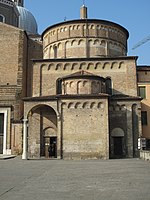Padua Cathedral
1754 establishments in the Republic of Venice18th-century Roman Catholic church buildings in ItalyCathedrals in VenetoChurch buildings with domesRenaissance architecture in Padua ... and 4 more
Roman Catholic cathedrals in ItalyRoman Catholic churches completed in 1754Roman Catholic churches in PaduaRomanesque architecture in Padua

Padua Cathedral, or Basilica Cathedral of Saint Mary of the Assumption (Italian: Duomo di Padova; Basilica Cattedrale di Santa Maria Assunta), is a Catholic church and minor basilica located on the east end of Piazza Duomo, adjacent to the bishop's palace in Padua, Veneto, Italy. The cathedral, dedicated to the Assumption of the Virgin Mary, is the seat of the Bishop of Padua. The church building, first erected as a cathedral in the 4th century, has undergone major reconstructions over the centuries.
Excerpt from the Wikipedia article Padua Cathedral (License: CC BY-SA 3.0, Authors, Images).Padua Cathedral
Piazza del Duomo, Padua San Giuseppe
Geographical coordinates (GPS) Address External links Nearby Places Show on map
Geographical coordinates (GPS)
| Latitude | Longitude |
|---|---|
| N 45.406388888889 ° | E 11.871666666667 ° |
Address
Duomo di Padova
Piazza del Duomo
35149 Padua, San Giuseppe
Veneto, Italy
Open on Google Maps








